The Google Pixel 3 Review: The Ultimate Camera Test
by Andrei Frumusanu on November 2, 2018 11:00 AM EST- Posted in
- Smartphones
- camera
- Mobile
- Pixel
- Snapdragon 845
- Pixel 3
Display Measurement
The Pixel 3’s screen is an extremely important aspect of the phone, not just because it’s the centre-piece of a device, but also because Google’s choice of panel manufacturer. Last year’s Pixel 2 XL suffered from a compromising display made by LG, which in particular had very large issues regarding gamma as well as black clipping at low brightness levels.
This year, Google opted to swap display suppliers around, with the small Pixel 3 now featuring an LG panel while the bigger Pixel 3 XL uses a Samsung unit. Again unfortunately we don’t have the 3 XL at hand, but we can investigate the Pixel 3’s LG panel and make comparisons on the issue points that plagued last year’s 2 XL.
One thing of note that is a first for Google is the introduction of different display colour modes. This was introduced in Android P / 9 and was backported to last year’s Pixel 2. Google now offers a “Natural” mode which represents accurate sRGB and Display P3 D65 targets, a “Boosted” mode which increases the colour saturations, as well as an “Adaptive” mode which is a bit of a mess but shouldn’t be of any concern to people who don’t care too much about colour accuracy.
As always, we thank X-Rite and SpecraCal, as measurements are performed with an X-Rite i1Pro 2 spectrophotometer, with the exception of black levels which are measured with an i1Display Pro colorimeter. Data is collected and examined using SpectraCal's CalMAN software.
Starting off with the greyscale measurements, I decided to switch over to full scale 256 level measurements to better showcase some of the characteristics of the panels, we’ll get back to this at the end of this page.
In “Natural mode”, the Pixel 3 is very accurate and manages to showcase a DeltaE2000 of 1.36, along with an average colour temperature of 6576K, which is very near the target D65 illuminant.
The phone has a maximum brightness of 407 nits – which is average of an OLED, as recent generation Apple and Samsung devices reach levels above 600nits. Google isn’t employing any auto-brightness boost mode, so sunlight legibility might be less than that of other devices, however I wasn’t able to test this directly in the cloudy weather.
Gamma came in at 2.18 – however looking at the curve it’s notable that for most levels it’s at around 2.3, and the average is brought down by being too bright in the last 5% of levels.
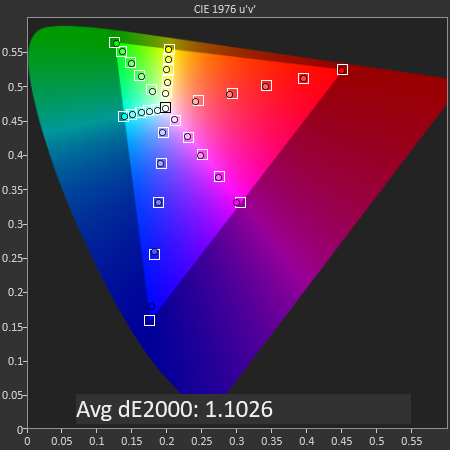
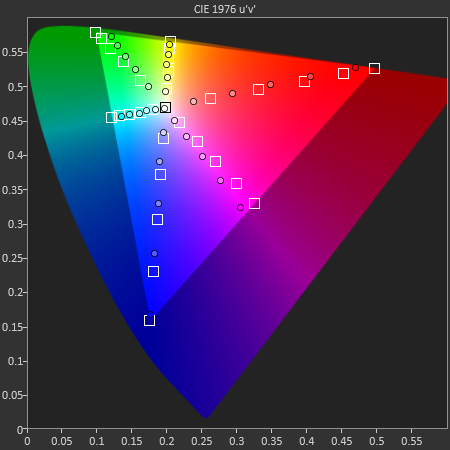 SpectraCal CalMAN
SpectraCal CalMAN
sRGB in "Natural" and in "Boosted" (Against Display P3 Gamut)
When in “Natural” mode, all non-colour managed content targets the sRGB colour-space. Here the Pixel 3’s screen is very accurate with a dE2000 of 1.1, among the best in terms of colour accuracy.
Selecting the “Boosted” mode linearly increases the saturations within the sRGB space – the resulting gamut doesn’t adhere to any standard. The adaptive mode is a complete mess in terms of colour gamut as well as targeting a high gamma of 2.5 – we’ll get back to that into a bit.
Google introduced OS level colour management support in Android 8, however the implementation on the Pixel 2 wasn’t finalised and there wasn’t any application support as of last year. With the Pixel 3 I had hoped that Google would progress on this, however to my great disappointment I didn’t find a single out-of-the box application which would support wide-gamut content.
To demonstrate the issue, you see the Pixel 2, Pixel 3 and an iPhone XS showcasing sRGB and Display P3 images alongside each other in the above photo. By default on Chrome, both sRGB and P3 images are equal, while the XS correctly showcases the higher saturation of the full-level red of the P3 image.
There is one way to bypass this issue, and that is to explicitly tell Chrome to override the default provided system colour profile and just tell it the display is Display P3. This enables colour management in the app, and short of writing a custom application, is the only way to get wide colour gamut content to work on the Pixel 3.
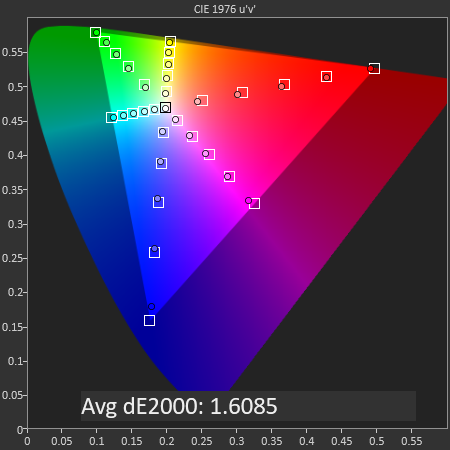
 SpectraCal CalMAN
SpectraCal CalMAN
Display P3 in "Natural" and in "Boosted"
Now one of the big questions I’ve had this year is how the CMS would interact with the actual display colour profiles in the settings. Fortunately, it’s pretty straightforward: The “Natural” mode isn’t per se a colour gamut selection, is just an actual category which has both accurate sRGB and P3 display modes via the CMS.
Testing out the Display P3 targets, the Pixel 3 showcases a good dE2000 result of 1.6. The display didn’t score better because seemingly the blue spectrum isn’t fully hitting the target saturations, something that also happened in the sRGB targets. Testing the P3 targets in the “Boosted” mode, we see again what is happening is that this mode just linearly increases the saturations. The blues are nearer to the P3 targets but all other colours overshoot the P3 target now.

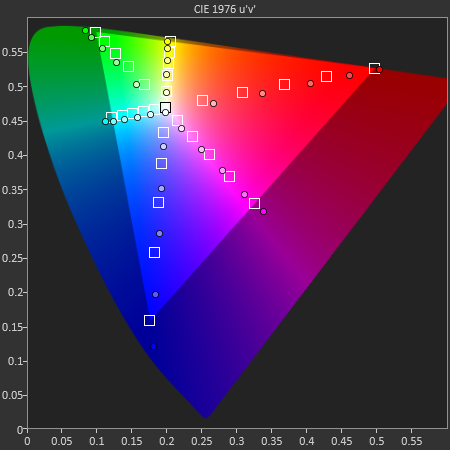 SpectraCal CalMAN
SpectraCal CalMAN
sRGB and Display P3 Targets in "Adaptive"
Now the fun thing is testing what happens with the sRGB and Display P3 images when you’re in “Adaptive” mode. sRGB obviously is quite a disaster – I didn’t manage to match this resulting gamut to any existing standard so there’s no real point in measuring an error rate. Now what is really interesting is to see the CMS expand the resulting visible gamut with the P3 images – here we’re seeing something that is far wider than Display P3, especially in the blues. Again this doesn’t really match any standard gamut, so there’s no point in making direct comparisons.

SpectraCal CalMAN
GretagMacBeth in "Natural"
The GretagMacBeth colour test in natural mode results in accurate colours with a dE2000 of 1.28.
Gamma curves under magnifying glass
One of the reasons I want to switch to full 256 level greyscale testing is to better show case the luminance behaviour, specifically highlighting the issue of “black clipping”.
The Pixel 2 XL, along with the LG V30, suffered very badly from black clipping at low brightness levels. I generally attribute this to the fact that those generation panels just used the DDIC’s ADC bit-depth for both colour representation as well as brightness control. Samsung OLEDs use PWM on top to control brightness by just adjusting the duty level – with voltage of the pixels determining the colour intensity. The Pixel 2 XL and V30 seemed to lack sufficient range to cover the level-spectrum at the low-end, and this resulted in notorious black clipping.
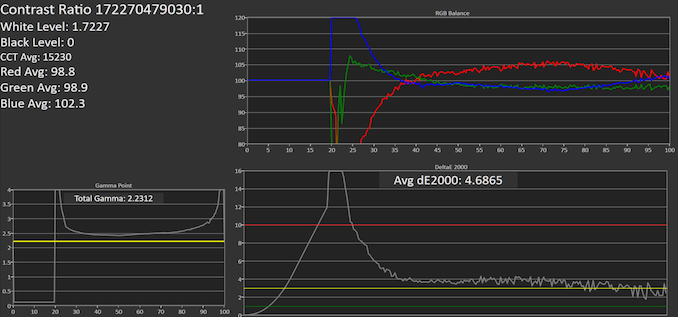
SpectraCal CalMAN
Pixel 2 XL
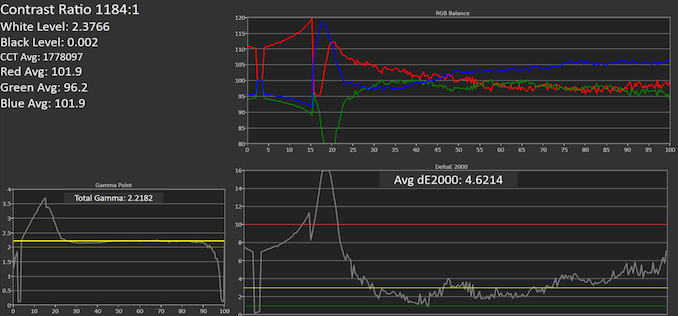 SpectraCal CalMAN
SpectraCal CalMAN
Pixel 3
At minimum brightness, the Pixel 3 improves over the Pixel 2 XL in this regard, but it’s still pretty terrible as it’s clipping 15% of levels to black, as opposed to 25% of the Pixel 2 XL.
The higher the brightness, the less pronounced the issue is. At 200 nits compared across the Pixel 3, Pixel 2 XL, S9+ and an iPhone XS, we see that all of the Android phones are clipping the first few greyscale levels to black, with Apple being the only manufacturer able to perform excellently in this regard.
Also one thing that becomes evident when doing full-scale 256 level measurements is the fact that the Pixel 3 colour balance across levels is very haphazard, and we see quite a zig-zagging behaviour between the intensities at different levels, also represented by the dE2000 results. In absolute terms, this shouldn’t be an issue as overall the error rate is acceptable, however it’s a stark behavioural contrast to any other phone I’ve measured before.
Overall, the Pixel 3’s screen is an improvement over the Pixel 2 XL, however it doesn’t fully solve the low-brightness issues that are plaguing LG’s OLED panels, and Samsung panels such as on the Pixel 2 are still better this this regard.
In terms of colour accuracy, the Pixel 3 performs well. Here I would have hoped that Google would have gotten wide colour gamut support fully working within its applications – currently the only way to get this to work is to change a Chrome settings flag, and this only solves the problem for Chrome, and no other app.
Lastly, the display brightness is good, however again it’s just adequate at up to 400 nits, and fails to compete with super bright displays from competing flagships.


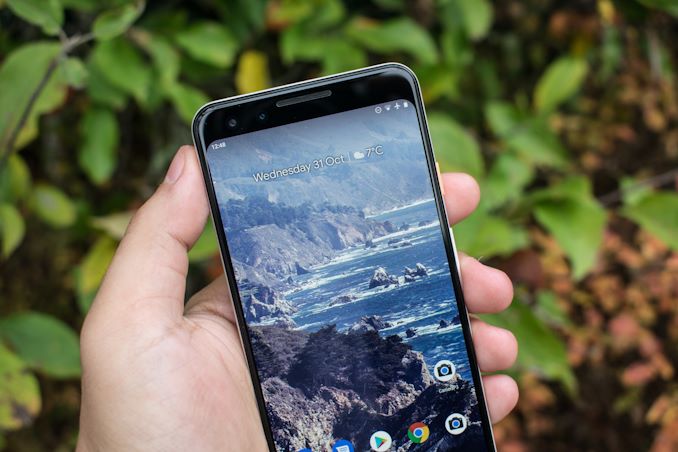
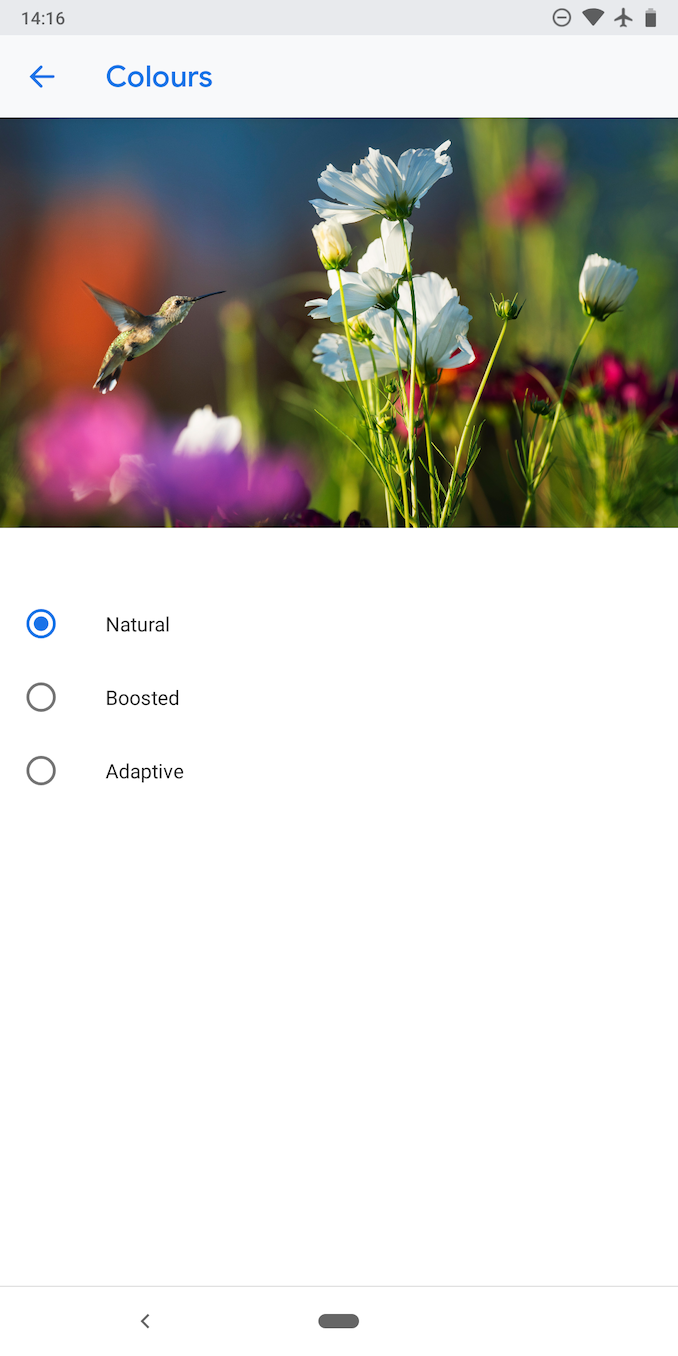
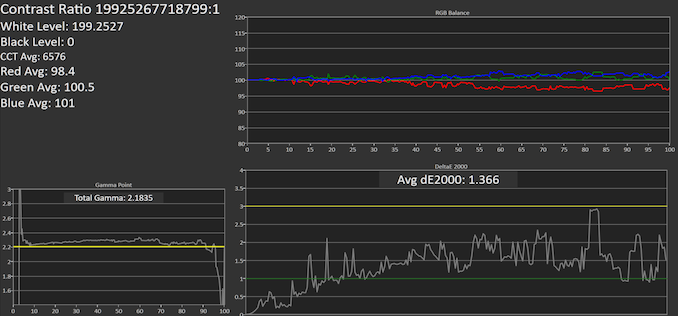

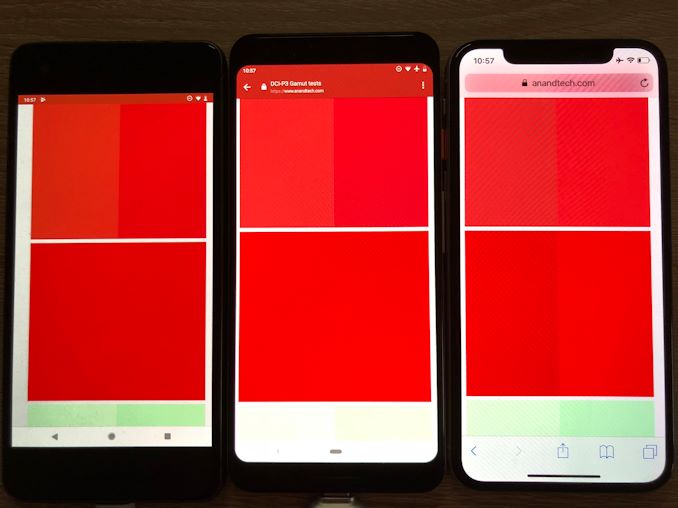
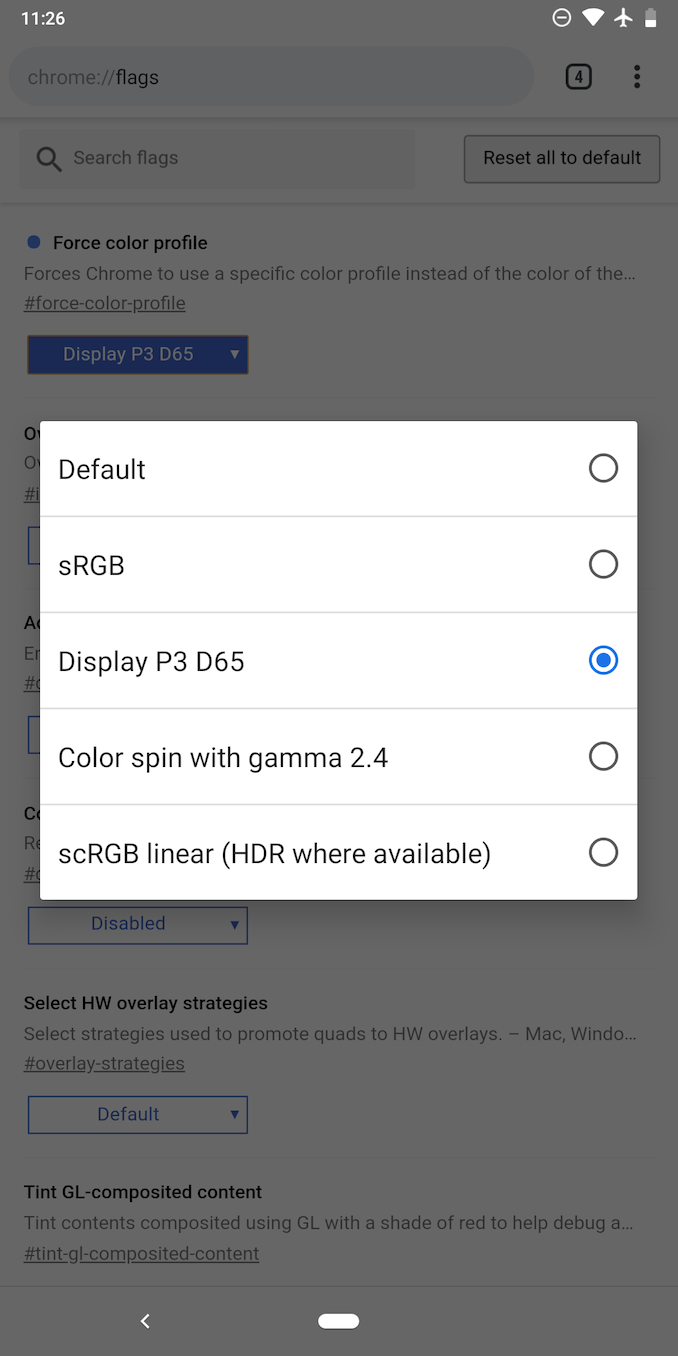









135 Comments
View All Comments
zanon - Saturday, November 3, 2018 - link
>"But we're not on version 1.0 of Bluetooth, we're on version 5.0 and it's still not great."It is great (or at least getting close) from some vendors, which shows that the technical foundation is there. Once that exists the only real way to have progress happen sustainable is to have a market for it so hundreds to thousands of attempts will be made, most of which will be mediocre, but some of which will be good and then get copied/followed in turn. To your own point:
>"Lots of people use Wi-Fi even though wired ethernet still exists."
WiFi was introduced *20 years ago*. Yes, 1998. And it stunk. It was a long time before it even achieved the kind of technical spec it needed, 802.11n took 11 years, 802.11ac took 15 years. Both came after smartphones and notebooks overtaking desktops, demand drove innovation and pricing. Of course, even now in 2018 a lot of WiFi stuff on the market is still junk and will still give a bad experience, but at least there are good options.
I think a better example would be USB replacing PS2 & ADB ports. Wow were there a lot of howls over that. We're seeing some of the exact same thing now in fact with USB-C and TB3, and people raging about adapters and "everything was fine before" and the early pains of these standards (plenty of junk USB-C implementations). But the fact is USB-C is a nice connector that solves physical and speed problems.
>"I just don't think it's 100% there yet and removing wired connections doesn't seem to add anything to the phone."
I absolutely agree it's not 100% there yet! There is clearly a ways to go. But I also don't think it'll ever go from 20% or even 50% to 100% in one leap either, no matter when they started the first few versions would have compromises. But I've seen more progress in the last year then the last decade, and once people know that something can be done well it tends to drag up the industry because customers are less willing to accept excuses of "oh nobody can do this."
mrvco - Sunday, November 4, 2018 - link
Agreed. I have a couple pairs of BT headpones and the convenience is nice... until the battery runs out when I'm boarding an international flight. I'm still using a Pixel XL as my daily driver and just ordered an LG v40. I also have an iPhone 8plus for app testing / demos and keeping track of the dongle is annoying.I still haven't heard a compelling reason for removing the headphone jack beyond pedantic and otherwise pointless spec sheet glossing. I'll take a slightly thicker phone all day and everyday if it means a larger battery and the same goes for a phone with a headphone jack.
Arbie - Monday, November 5, 2018 - link
What a rant! But what could you do except blather about "forcing the future" and "a few generations will have to deal with compromises"? That malarkey lost all meaning long ago; maybe you missed the memo.I have a BT headset for when I want to listen and be mobile - only. Compared to my wired earbuds it's bulky, heavy, expensive, complex, requires setup, creates rub noise, *and* needs daily charging. Now - add a dongle with similar issues! In all those aspects, wireless is a regression even it if works flawessly. If we had only that, and someone invented wired phones, it would be hailed as a miracle because, where they are convenient, those have no equal.
So removing even the option of wired is stupid *unless* there is some major compensation for doing so. I don't see any, and you don't either.
nonig - Wednesday, November 14, 2018 - link
Rarely has a post resonated with me like this one has. I wholeheartedly agree.Back when Apple announced, that they'd be dropping the minijack I thought "damit!" as I almost just had gotten a decent headset for my phone. I like to listen to music and the thought of having to accept wireless only irked me.
On the other hand, I am a tech enthusiast and had two years prior gotten my first tenure and therefore a decent salary - so I thought to myself; why not splurge and get a 'real' high end headset? I got myself the Beoplay H8 (around $350 I think) and haven't looked back.
My only alternatives was the Airpods or a headset similar to the B&O (Denon, Bose, Sennheiser, B&W and so on).
To me, it marked my final maturity into the form of 'good enough'-adulthood. I don't need 'wannabe pro'-performance or other pseudo/placebo. It just has to work, be good enough and reliable. Never really being able to put it into words until I read your post - and I totally agree.
I too used to claim, that only wired was good enough, until I got used to the comforts of WiFi.
I too used to claim, that FireWire400/800 was infinitely superior to USB2.0/3.0, until I tried a newer USB3.0 external hard drive.
I too used to claim, that only the golden terminals on my SoundBlaster Audigy was good enough for my MP3's until I realized it just doesn't matter.
I too used to claim, that CDs was superior to AAC or whatever, until discovered the joy streaming music.
I too used to claim, that the only way to enjoy movies was on bluray, until I realized I just wanna watch movies and not bother with stupid intros, trailers, copyright/piracy splashes - Netflix, HBO, Youtube (still ads, but 5 seconds is manageable).
I too used to claim, that the only way to enjoy audio was on the B&W speakers via our NAD amp, until I realized bitrate doesn't determine how much I (or my kids) like a song or not.
So on and so forth.
Today, I just don't bother anymore.
Music is best enjoyed when I don't have to untangle stupid wires first. I just put on my headset, turn them on, and instant music or Airplay to our wireless speakers around the house - provided the kids hasn't hidden them somewhere.
I guess people don't like change (I'm not claiming that they're stuck up or something, just that sometimes change doesn't seem rational when 'the old stuff seems to work just fine') and I like your point.
Let's get back to serial and parallel ports, so much easier, when different things use different ports. Today, everything is USB and it can be soooo confusing.
Let's get back to when phones only used to be phones.
Let's get back to when cameras was cameras.
Let's get back to when portable music devices used cassette tapes.
Let's get back to when cars was jump started by hand.
Let's get back to using horses. Less pollution! (I honestly don't know, if replacing combustion based motor transportation with live stock would decrease pollution - XKCD/Randall are you reading this?)
Anywho.
All I wanted to say was; I agree.
erple2 - Thursday, November 22, 2018 - link
I'm not that averse to new tech, provided it eventually (fairly quickly) surpasses what it is replacing. In the case of bluetooth (version 5 no less), we're still not there yet. My cheap (~$20) bluetooth headphones don't always work, have issues with: mediocre sound, noticeable audio lag, and have to be charged, and don't really last that long on a charge. By contrast, my cheap (~$8) wired headphones always work, have mediocre sound, no audio lag, don't need to be charged, and don't cause a small (but noticeable) drain on my phone's battery life.Each of the other things you mentioned saddened me with the race to acceptance of mediocrity, though :( While I appreciate the conveniences of WiFi, I still plug my laptop in to wired connections when reasonably possible - it's just faster in all cases, and more reliable. That's kind of a problem with most new technology - I'm just not sure if the improved convenience of new technology always makes up for its shortcomings (hint: it only sometimes does).
amosbatto - Friday, November 30, 2018 - link
These kind of comments really annoy me. First of all, you are needlessly promoting planned obsolescence for no tangible benefit. Millions of headphones and speakers all over the planet will be thrown away for no good reason, except that Apple figured out a way to make more profits selling us dongles and Beats wireless headset. I have a hi-fi system that I bought in high school which will never work with Bluetooth. You are telling me to throw out a $1000 system, just because it doesn´t work with Bluetooth and replace it with Bluetooth speakers of lesser quality.Bluetooth´s quality still isn´t as good as a wired audio. I have had very bad experience with Bluetooth ear buds. First, I bought some Apple-style ear buds, that don´t have a wire. Two days later, I was washing dishes and it slipped out of my ear and fell in the sink and the water destroyed it. Next, I bought a Bluetooth set with wires connected to a magnetic clip. I´m guessing that the clip wasn´t strong enough, because I lost it when walking. These experiences have convinced me to return to wired ear buds.
imaheadcase - Saturday, November 3, 2018 - link
What are you having problems with wireless? Every smartphone i've had i've used the bluetooth all the time and never had a issue with it.Wireless is just plain silly to have now-a-days, wireless is better for working, running, pretty much all aspects.
ummduh - Saturday, November 3, 2018 - link
Literally every bluetooth connection I have is problematic. I only have 2 left due to having so many issues with it. I HATE BT. I don't know who's fault it is, the accessory devices' implementation, or differences in phone manufacturers' implementation, but it doesn't really matter. I consistently have problems with it. It never just works for me.cfenton - Saturday, November 3, 2018 - link
I have connection issues. When I turn my headphones on, sometimes they only grab the call audio output, but not the media audio output. I have to go into my bluetooth settings to fix it and that's a hassle, especially when I'm out in the winter with gloves on.Impulses - Saturday, November 3, 2018 - link
I'm not gonna defend dropping the jack, but these instances where people swear they have to fiddle with settings each and every time they pair BT stuff can only be due to two things... Bad software (some phones/devices do have a shitty BT stack, and Google is often on the latest which doesn't always play nice with older stuff) AND/OR an incredibly noisy RF environment. I don't often encounter the latter, but I don't live in an apartment or the middle of NYC.